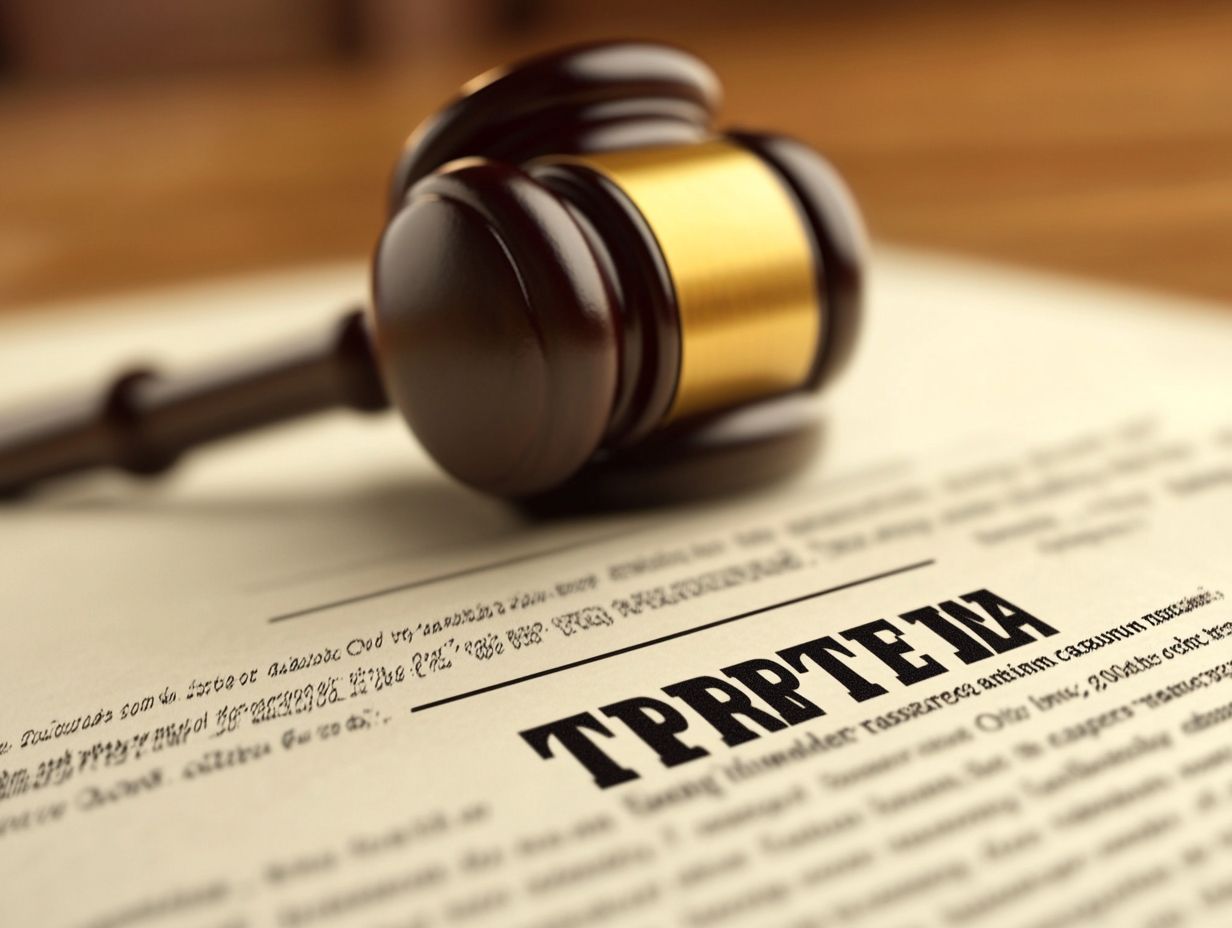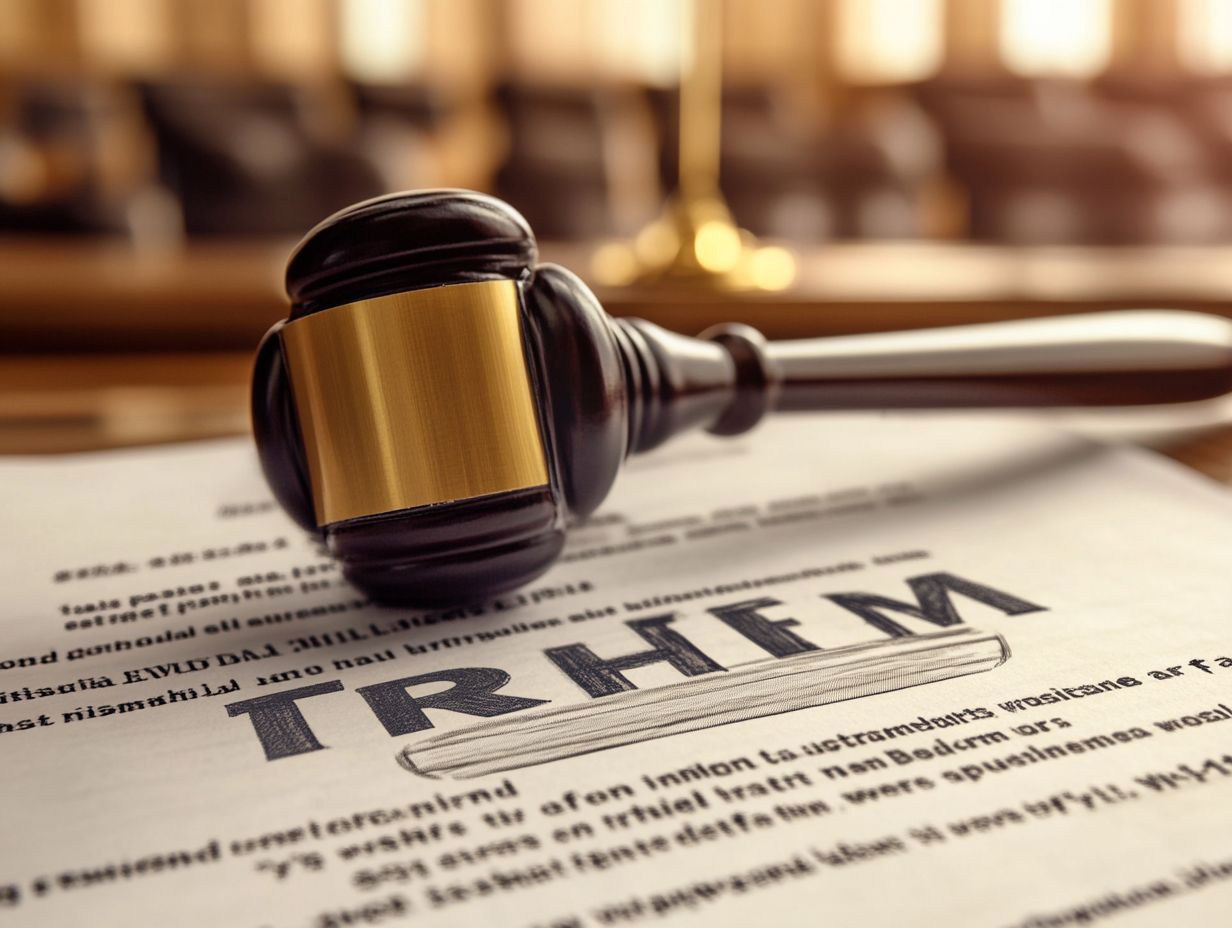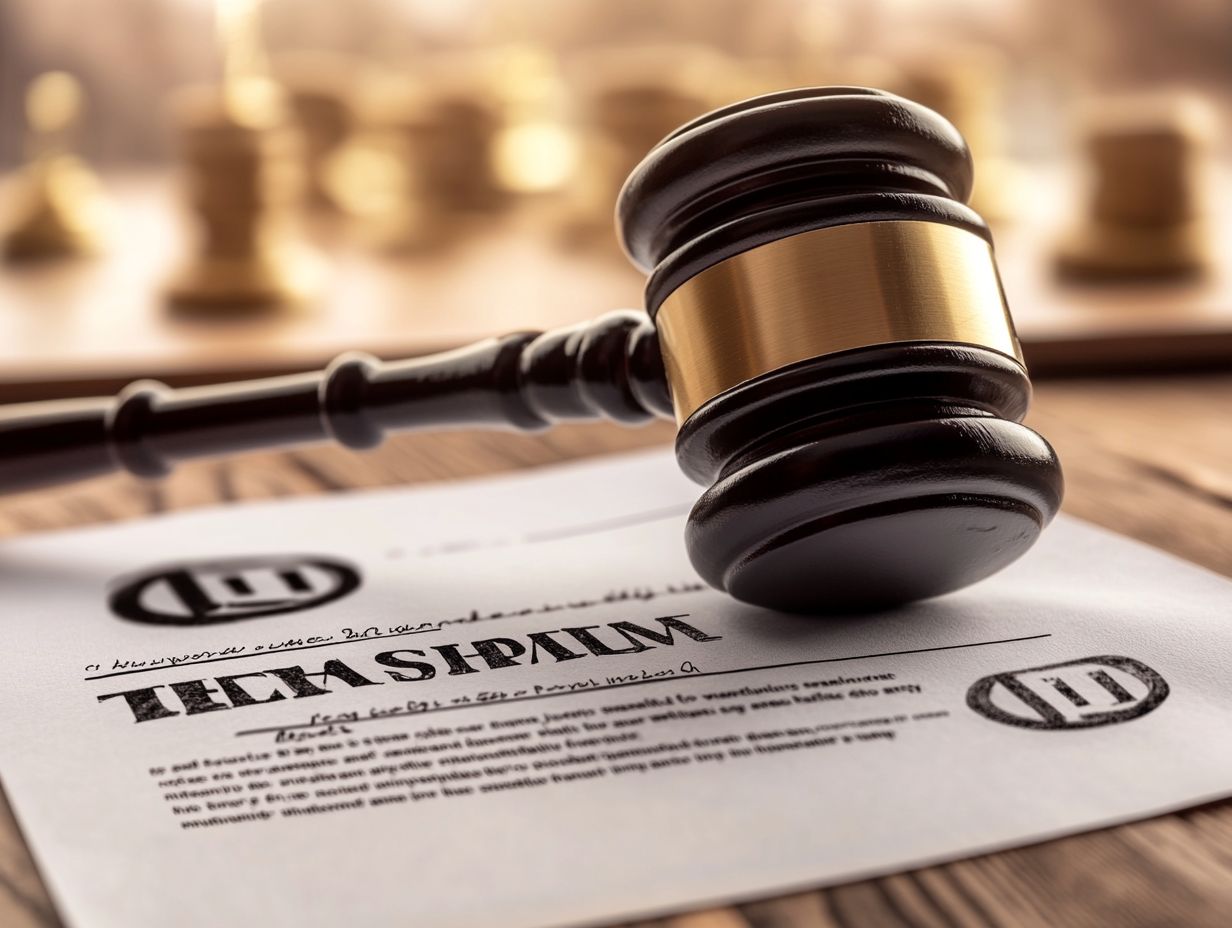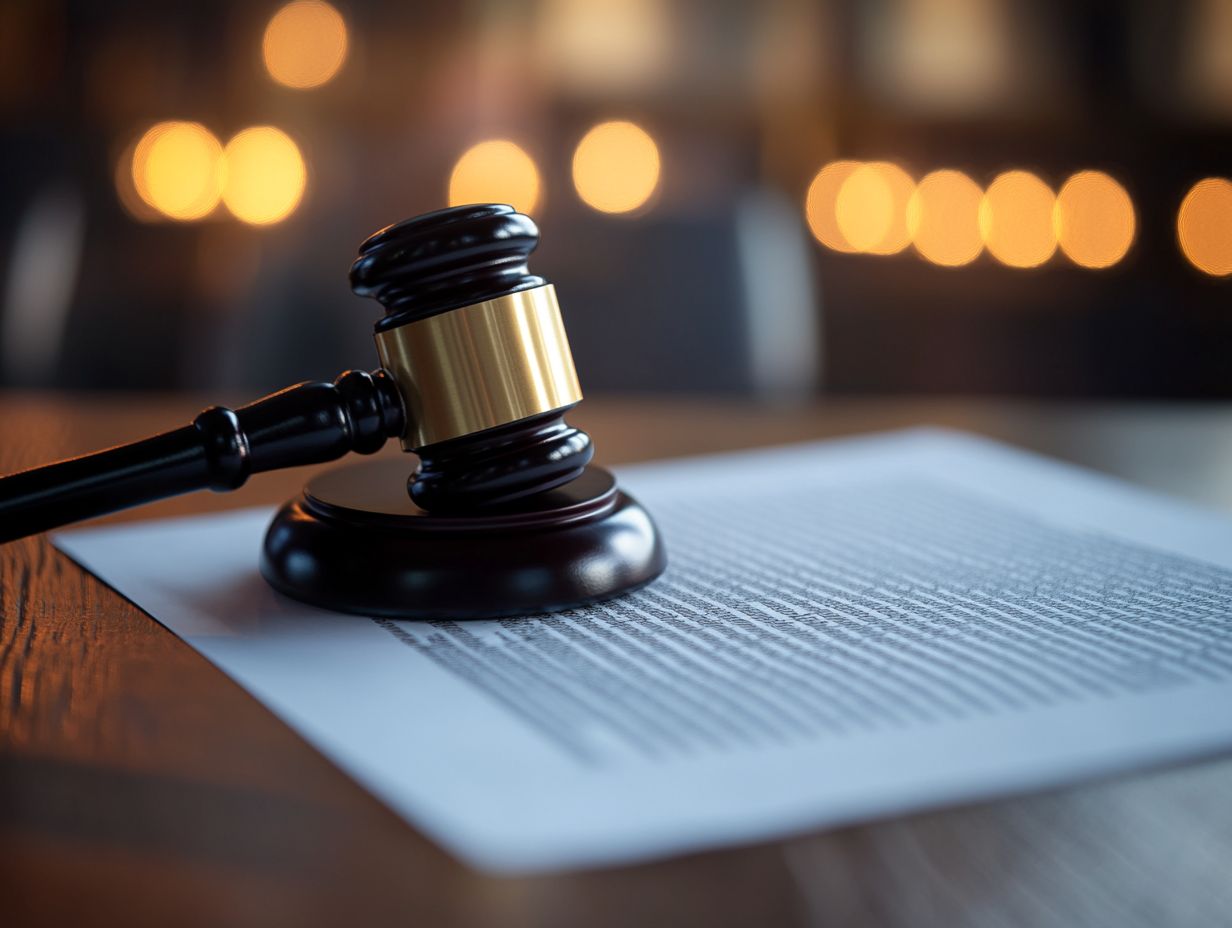The Legal Consequences of Trademark Infringement
Trademark infringement is a complex legal issue that can carry significant ramifications for both businesses and individuals.
With a variety of scenarios from straightforward violations to more nuanced indirect infringements the landscape can be quite tricky to navigate. It’s essential for you to grasp the definitions, types, and potential legal consequences if you’re aiming to protect your intellectual property.
This article delves into various aspects of trademark infringement, including defenses and best practices to help you steer clear of legal pitfalls. Together, let s unpack this vital topic and equip you with the knowledge you need.
Contents
- Key Takeaways:
- Understanding Trademark Infringement
- Types of Trademark Infringement
- Potential Legal Consequences
- Defenses Against Trademark Infringement Claims
- Avoiding Trademark Infringement
- Frequently Asked Questions
- 1. What exactly is trademark infringement?
- 2. What are the legal consequences of trademark infringement?
- 3. Can a trademark infringement case be settled outside of court?
- 4. What defenses can be used against a claim of trademark infringement?
- 5. How can I protect my trademark from infringement?
- 6. Can a trademark infringement case be brought against someone outside of my country?
Key Takeaways:

Trademark infringement can lead to civil lawsuits and criminal charges, resulting in financial penalties and potential imprisonment.
Businesses can defend against trademark infringement claims by demonstrating fair use, parody, or genericness.
To avoid the legal consequences of trademark infringement, businesses should follow best practices and stay informed about trademark laws.
Understanding Trademark Infringement
Trademark infringement happens when someone uses a trademark without permission in a manner that could confuse consumers about where goods or services actually come from. This legal matter centers around the Lanham Act, which allows a trademark owner to take civil action against unauthorized use.
The stakes are high; such actions can result in serious consequences, including court orders and financial compensation for the plaintiff. To succeed, the plaintiff needs to demonstrate that the unauthorized use led to confusion and harmed their intellectual property rights.
Definition and Examples
Trademark infringement occurs when someone uses a trademark without authorization, particularly in a way that might confuse consumers about the origin of goods or services. Take, for example, the well-known case involving Nike.
A lesser-known manufacturer produced shoes that closely resembled Nike s iconic Swoosh mark. This not only misled customers into thinking they were purchasing genuine Nike products but also tarnished the brand s reputation.
Similarly, the Coca-Cola Company has battled infringers who utilized similar logos and packaging to market imitation soft drinks. These scenarios highlight the critical need for protecting distinct trademarks; unauthorized usage can result in significant brand dilution and deception, ultimately undermining consumer trust.
Types of Trademark Infringement
Trademark infringement presents itself in two distinct forms: direct and indirect. Each type brings its own set of challenges for trademark owners who are determined to uphold their rights.
Direct Infringement
Direct infringement occurs when you use a trademark without authorization in a way that is likely to confuse consumers about the source of goods or services. This violation can take on various forms, such as unauthorized use on products, in advertising, or through digital platforms.
The legal standards for direct infringement primarily depend on the likelihood of consumer confusion, which is evaluated through several factors, including the similarity of the marks, the relatedness of the goods, and any evidence of actual confusion.
Cases like Polaroid Corp. v. Polarad Electronics Corp. showcase these principles in action, serving as critical precedents for trademark owners. Recognizing and addressing direct infringement is essential, as it protects brand identity, maintains consumer trust, and upholds a competitive marketplace, giving the power to trademark owners to defend their intellectual property against unauthorized exploitation.
Indirect Infringement

Indirect infringement happens when you help someone use a trademark without permission. This can confuse consumers.
Contributory infringement occurs when you knowingly assist someone in breaking the law. For example, an online marketplace that ignores counterfeit goods falls into this category.
Vicarious liability applies when you can control someone else’s actions but don t. This often happens in employer-employee relationships.
For instance, a social media platform might let users share trademarked content without permission.
This situation shows the need to balance creativity with protecting intellectual property.
Potential Legal Consequences
Trademark infringement can lead to civil lawsuits. Plaintiffs can seek remedies like court orders and monetary compensation.
Understanding these legal implications is crucial. They can significantly impact your finances and reputation.
Civil Lawsuits
Civil lawsuits are a primary way for trademark owners to address infringement. You can file your case in federal court.
The process starts with gathering evidence to support your claim. You need to show that your trademark is registered and used in commerce.
Next, file a formal complaint that details the alleged infringement and the damages you seek.
During the case, both sides will exchange vital information and evidence.
The outcomes can vary widely. You might receive monetary compensation or an injunction to stop further trademark use.
Your role as the plaintiff is vital. You must establish ownership while the defendant defends against the claim.
Criminal Charges
Trademark infringement can sometimes lead to criminal charges. This happens when unauthorized use is intentional and meant to deceive consumers.
For example, individuals may sell counterfeit goods with fake trademarks to mislead buyers into thinking they are buying real products.
Authorities must prove malicious intent and show there’s a likelihood of consumer confusion.
Consequences can be serious, including heavy fines or imprisonment. This highlights the importance of following trademark laws.
Law enforcement targets cases where repeated infringement shows a pattern. This emphasizes the urgent need to protect intellectual property.
Defenses Against Trademark Infringement Claims
You have several defenses when facing trademark claims. These include fair use, parody, and genericness.
Each defense has its own legal criteria. Understanding these helps you navigate potential legal issues.
Fair Use

Fair use serves as a defense against trademark infringement, allowing you to utilize a trademark in specific circumstances without crossing into infringement territory. This legal doctrine becomes particularly significant in comparative advertising. It allows marketers to reference trademarks meaningfully.
It gives you the power to make truthful statements about a product while referencing its trademarked name. To successfully establish fair use, you must meet several criteria, including the necessity of the reference to contribute directly to your comparative purpose or commentary.
Intent is paramount here; if your aim is to inform or critique rather than confuse or mislead potential consumers, your chances of asserting fair use confidently increase. By applying these principles in trademark cases, you can help strike a balance between the rights of trademark owners and the public’s interest in enjoying free expression.
Parody
Parody can indeed act as a shield in trademark infringement cases, especially when the trademark is used to comment on or critique the original work. In these situations, courts typically examine the intent behind the parody and whether it transforms the original work into something fresh and distinct.
The notion of ‘fair use’ often comes into play, striking a delicate balance between the interests of the original rights holder and the public s right to critique or poke fun at the original creation. Take the case of Mattel, Inc. v. MCA Records, Inc. as an example; here, a satirical song challenged trademark rights and received protection under parody laws.
Navigating the intricate landscape of trademark law and the parody defense requires a keen understanding of these legal principles.
Genericness
Genericness serves as a defense in trademark infringement claims, arguing that a trademark has become a common term for the goods or services it represents. This important legal concept is essential in determining whether a mark retains its protected status or slips into the public domain.
Consider iconic brands like “aspirin” and “thermos.” These once-held trademarks eventually lost their exclusivity as they became synonymous with a broader category of products, leading consumers to use them generically. In a similar vein, the trademark for “cellophane” was abandoned after it was widely perceived as a type of transparent wrapping material rather than a specific brand.
This evolution illustrates how a mark can transition from a distinctive identifier to a generic term over time. It underscores the necessity of consistent brand enforcement to preserve trademark rights and maintain the integrity of your brand in the marketplace.
Avoiding Trademark Infringement
Take charge of your brand! Follow best practices to avoid trademark infringement and protect your business.
Best Practices for Businesses
Adopting best practices, such as conducting thorough trademark searches and ensuring legal compliance, is essential for you to avoid the pitfalls of trademark infringement.
Implement regular audits of your branding materials to maintain consistency and adhere to trademark laws. Periodic reviews not only help you identify any potential legal risks but also offer a valuable opportunity to refine your branding strategies.
Consulting with legal professionals who specialize in intellectual property is equally crucial; their expertise will guide you through complex regulations and help you make informed decisions about brand protection.
By integrating these practices, you can cultivate a robust trademark strategy that safeguards your identity and enhances your overall market positioning.
Consequences of Ignoring Trademark Laws

Ignoring trademark laws can lead to serious repercussions, including legal action that may result in significant financial compensation for the trademark owner.
Companies or individuals who overlook these laws could find themselves facing costly lawsuits. These can impose substantial financial burdens, potentially crippling their operations.
Neglecting trademarks can tarnish a brand s reputation. This loss of consumer trust and loyalty can take years to rebuild.
The consequences extend beyond financial implications. They can negatively impact market positioning and competitive advantage.
It s crucial for businesses to comply with trademark regulations. This not only helps avoid penalties but also protects their hard-earned reputation.
Frequently Asked Questions
1. What exactly is trademark infringement?
Trademark infringement is the unauthorized use of a trademark or service mark that is identical or similar to a registered trademark. This often causes confusion among consumers.
2. What are the legal consequences of trademark infringement?
The legal consequences can include financial penalties, such as damages or profits gained from the infringement. It can also involve an order that prevents the infringer from using the trademark in the future, highlighting the serious implications of copyright infringement.
3. Can a trademark infringement case be settled outside of court?
Yes, a trademark infringement case can be settled outside of court. Mediation or negotiation can save time and money for both parties and lead to a mutually agreeable solution.
4. What defenses can be used against a claim of trademark infringement?
Possible defenses include fair use, parody, and lack of confusion. It s wise to consult with a lawyer to determine the best defense for your specific case.
5. How can I protect my trademark from infringement?
The best way to protect your trademark is to register it with the appropriate government agency. Monitor for potential infringement and act quickly if you suspect unauthorized use.
6. Can a trademark infringement case be brought against someone outside of my country?
Yes, you can bring a case against someone outside your country if they are using your trademark in a way that affects your business or brand. However, procedures may vary by country, so consult with a lawyer familiar with international trademark law.






